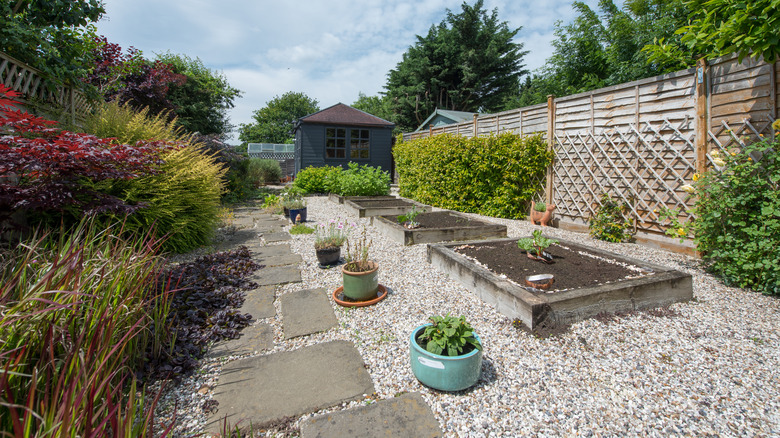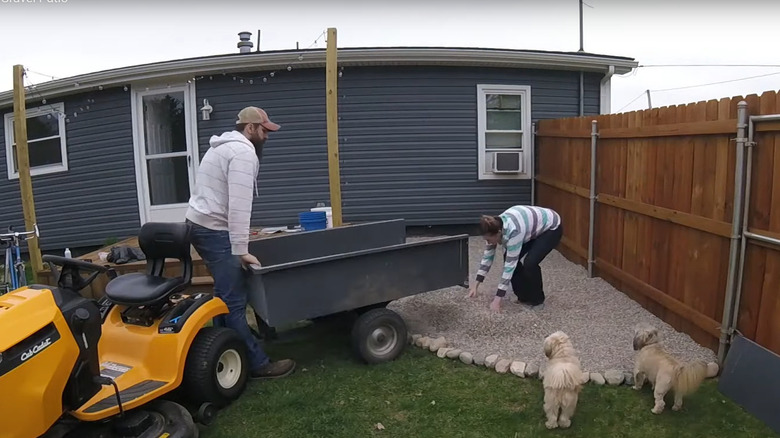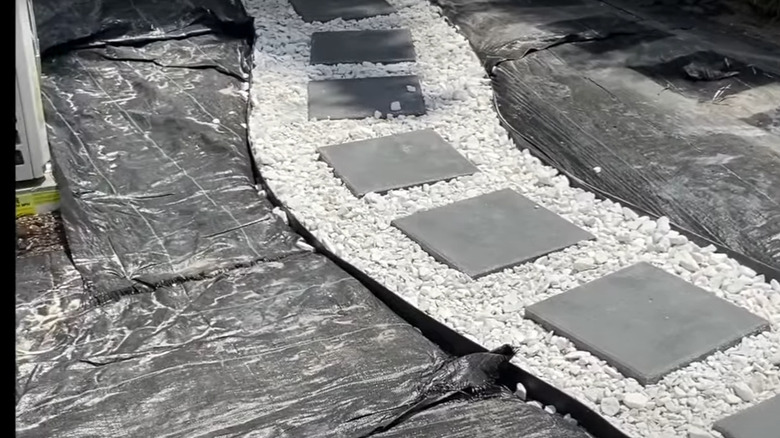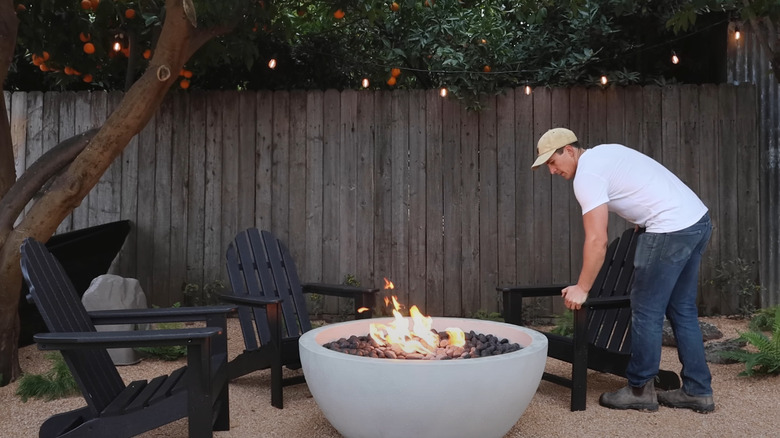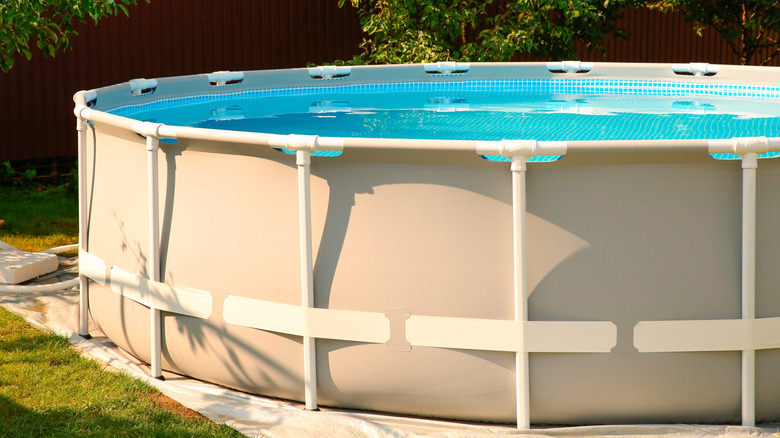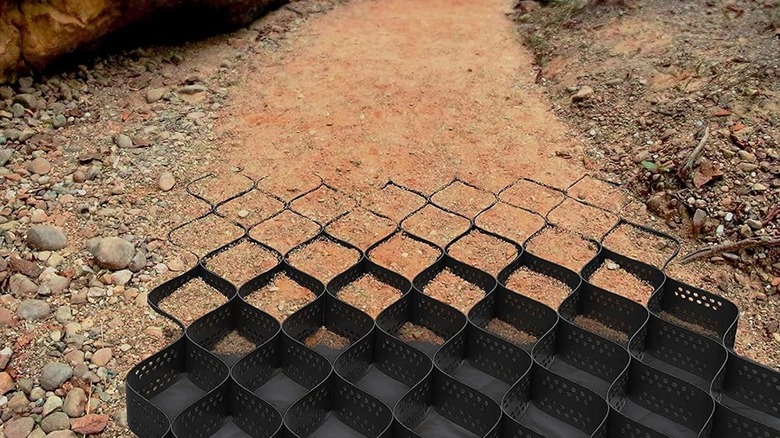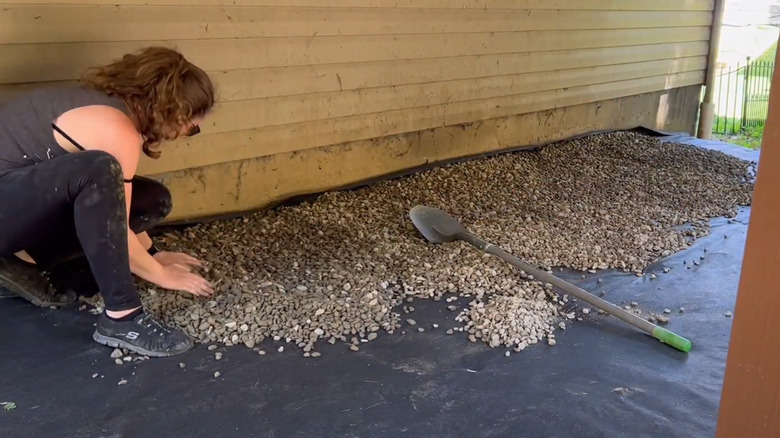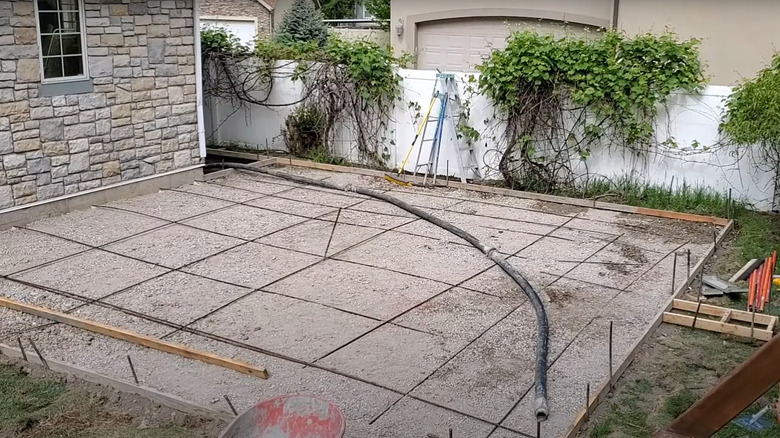All The Ways You Can Use Gravel In Your Yard
We may receive a commission on purchases made from links.
Gravel isn't just for driveways — there are tons of creative ways to utilize it in your landscaping to create unique and eye-catching designs. Not only is it budget-friendly and easy to find, but it also comes in many forms, giving you variety. For instance, it comes in sizes one through 10, from the largest to smallest stones. Choose between washed or unwashed, different rock colors, shapes, and types to pick the best-suited for a project at hand. Basalt, granite, limestone, and sandstone are popular rocks in gravel mixtures, and crushed stone, lava rock, marble chips, pea gravel, and river rock are some of the most popular gravel types.
Most of these projects use small gravel pieces around ⅜ inch to 1½ inch in size and in sharp rock form, which is better for stability purposes. When installed correctly, gravel benefits local environments as well as your home value and landscape. Read on to learn what home projects use gravel, the perks of using it, and how to implement this material.
DIY a budget-friendly gravel patio
A pea gravel patio is a great option for people on a budget. However, there are some things to consider before installing a gravel patio. For example, its lifespan pales in comparison to cement patios, so it might not be the best pick for people looking to create a permanent outdoor space that will last decades. However, it does hold up for years, making it well worth the cost and effort as long as it's maintained and replenished.
To make it DIY -friendly, level the bumpy land without heavy equipment before construction. YouTubers The Inexperienced Adventurers built their 12-foot by 20-foot patio using 4 cubic yards of pea gravel and 2 cubic yards of fieldstone rocks. They laid fieldstone rocks as perimeter pieces and used them to pin down landscape fabric. The DIY YouTubers then filled the center with pea gravel and posted an update one year later showing the still-intact design. Over time, rain and foot traffic scatter the crushed rock pieces, thinning them out until the fabric layer is visible underneath, at which point refilling is necessary. If the fieldstone border is at least ½ inch taller than the pea gravel flooring, it's easier to keep it contained.
Depending on the size of the patio, you'll need one or more sheets of UWIOFF 4ft x 50ft Garden Weed Barrier Landscape Fabric. This fabric comes with 10 landscape pins, though heavier-duty ones like the WhistenFla 6-inch Galvanized Landscape Staples are only $6.95 for 20. The gravel you use is up to your preference, but Home Depot's most popular Vigoro Bagged Pea Gravel Pebble Landscape Rock is only $5.97 per half cubic foot. Larger rocks tend to cost more, and you can buy Vigoro Bagged Creek Landscape Rock for $9.98 per cubic foot.
Lay a gravel border along a driveway or your house's side
Pouring a gravel border alongside your driveway and house siding adds more than aesthetic value. For instance, laying rock pieces improves drainage to reduce erosion (crushed rock has natural gaps for water to filter through). This prevents water from gathering in pockets that eventually cause cement or paved driveways to crumble and collapse. Gravel is also as good at fighting fires as it is preventing flood damage. Natural rocks are non-combustible and don't enflame like grass, mulch, and garden plants. A gravel perimeter can slow down fires, giving you and firefighters more time to evacuate your home and potentially save it during a wildfire.
The best gravel to lay along driveways and house siding is a crushed stone with rock dust, often called "quarry process", which usually contains a mix of granite, limestone, and other rocks. Pick a bag of gravel around ¾ inch to 1½ inch in size mixed with dust, which makes it aesthetically pleasing while being compact and stable. The amount of gravel you need completely depends on the perimeter of your house and driveway. Popular home improvement stores like Home Depot and Lowe's have calculators on their product pages to help estimate how much you need.
Use gravel to fill gaps between paver stones
A stylish paver walkway transforms a boring exterior all on its own. However, adding gravel between pavers adds more aesthetic appeal and stability while improving yard drainage. Use gravel as the base setting for pavers to create a moisture barrier for rain to filter through. Instead of slowly forming trenches around the larger stones, it'll disperse through the rocks, keeping walkways firmly in place for longer.
If you plan to lay the stones over compacted rock, use ⅜-inch crushed gravel, which is small enough to press into a malleable shape beneath the pavers. The dust and sand in the gravel mixture help with compaction to form a firm, flexible, and drainable base. Aim to have about 4 to 6 inches of gravel so water runs down instead of settling over the pathway. Although crushed gravel is better for compacting, you can also mix in some pea gravel for texture. Calculate your project's length, width, and depth beforehand so the supplier can help estimate how much you need to purchase. You can also use an online Paver Base Calculator.
Replace mulch with gravel to protect desert gardens and flowerbeds
If you decide a desert garden is the right yard choice for you, replace organic mulch with gravel. Organic mulch is better suited for most plants that thrive in moderate, semi-arid climates. If you plant a garden full of cacti and succulents, you're better off using pea gravel since it doesn't lock in moisture for as long as, say, wood chips. Since these fleshy plants don't like to sit in water and are susceptible to root rot, this would be a better choice overall. Plus, organic mulch is also known to attract bugs and decompose faster.
Weeds will still push between the gaps in large rocks, so choose gravel smaller than ½ inch to prevent these nuisances. Pea gravel is a common choice. Tractor Supply sells a 30-pound bag of Rain Forest Washed Gravel, which contains ³⁄₁₆ inch gravel pieces, for $24.99. Home Depot and Lowe's carry the same brand at a slightly higher price but have more colors to choose from. Fortunately, the smaller the rocks, the easier it is to style your landscape. Pile the rocks at least 3 inches deep so you don't have to replenish them for a long time, and border the smaller pebbles with a larger rock perimeter or another barrier to keep them corralled.
Create a safer fire pit with gravel
Gravel is a key player in firewise landscapes, naturally making it a popular material for fire pit seating areas. Whether you create a fire pit from scratch or buy a manufactured option, gravel is an excellent foundation because it makes lighting a fire a safer endeavor. The right gravel gives walking areas more traction, preventing people from slipping and falling. It also catches rogue flying embers without also bursting into flame like grass or wood can. This reduces the risk of accidental injury or fire while enjoying a cozy night.
Plan your fire pit at least 10 feet from your house, making sure you follow any HOA rules, local ordinances, home insurance requirements, and other legal regulations. Make sure the surface is flat and no trees are hanging overhead. If the surface isn't flat, it may be necessary to level the land. Create your fire pit area following the same recommendations for building a gravel patio. Use crushed gravel — preferably under ½ inch. Stones with jagged edges are easier for your shoes to grip without slipping.
Create a non-slip poolside area using geocell grids and gravel
Pavers are usually the go-to for a pool surround, but gravel is an underrated alternative to that smooth, potentially slippery-when-wet surface. Gravel is a great foundation option for above-ground pools when paired with a gravel pad and pool pad. The main perk of a gravel foundation is that it provides drainage when water splashes outside and when natural rainfall occurs. It's also a great material to surround pools with since pea gravel under ½ inch is less slippery and safer to walk on after a swim. However, one downside is that it might hurt to walk barefoot, especially if you get the safer, jagged pebbles.
Before building an above-ground pool foundation, level the land and pour enough gravel to be at least 4 inches deep. Pea gravel under 1 inch in size compacts easily and isn't as slippery when wet. Aside from the gravel base, you'll need a pool liner pad like the U.S. Pool Supply Store Armour Shield Heavy Duty Pool Liner Pad. Keep in mind that a larger pool will need a larger liner size. Also invest in a stabilization grid, like the MIWOOYY 2" Thick Gravel Ground Grid.
Before laying a gravel surround, make sure you have a way to keep it contained on both sides. You don't want the pebbles drifting into the nearby lawn. Many pools with pebble landscapes are either separated from gravel areas or have an additional raised barrier around the perimeter to keep the tiny rocks from falling in.
Prevent soil erosion on sloped walkways with ground grids and gravel
Sloped dirt and gravel paths are more common on hilly and mountainous properties. These paths are slowly worn by foot traffic, gravity, and natural rainfall. Keep tidy walking paths by installing ground grids with compacting gravel over the top. Ground grids are often made of plastic and have repeating hexagon- or square-shaped holes. The grid is secured over loose soil using clips, stakes, staples, or other methods, and gravel is poured into the plastic holes. The repeating hexagons or square holes hold the gravel in place over the ground, helping maintain pathways over years of use.
Gravel ground grids range in expense depending on the scope of your project. According to a survey of several brands by Washington Rock Quarries, prices range between $0.46 to $5.15 per square foot of gravel grid cells. This doesn't include the cost of additional installation supplies or the gravel filler. You should use at least two types of permeable gravel filler: a base layer and a top layer. The base layer should be between ¼ inch and 1½ inch in size, while the top layer should be around ⅛ inch to 1½ inch in size. Similar to most gravel projects, know the dimensions of your walkway before ordering a grid. You can find these grids under terms like "geocell" or "geogrid," and they're sold at major retailers like Amazon, Home Depot, Lowe's, and Tractor Supply.
Put gravel under a deck to impede weed growth
A wooden deck is built to last at least a decade. Performing routine maintenance and repairs makes it last even longer, and one of the ways you can extend its lifespan is by adding gravel underneath. You should put gravel under your deck to subdue weed growth, control erosion around the footings, improve water drainage, and reduce fire risk. It also improves the appearance of the canopied area while reducing maintenance and upkeep needs. You won't have to worry about maintaining the grass and weeds underneath the deck space if neatly placed gravel obstructs growth.
Use crushed limestone around ¾ inch, as this is one of the easiest to install. It's small enough to have aesthetic appeal, prevent weeds, and drain water effectively. You can also use river rock or pea gravel, though they don't compact as well as crushed stone. Before laying gravel, make sure you create a barrier to keep it from overflowing into the rest of your yard. Most people use 2 by 4 plywood pieces or large fieldstones to help maintain the perimeter. Deter weeds even further by pinning landscape fabric under the plywood or perimeter rocks.
Make a sports court at home using a gravel base
Building a sports court at home is more than every kid's dream – it's a great way to boost health and wellness for adults. There are important steps to take before adding a pickleball, basketball, or tennis court to your house, such as building a gravel foundation. Gravel is a great base material for sports courts that supports the top layer long-term. It keeps the court itself from shifting, pooling with water, and deteriorating prematurely. A gravel base also elevates the concrete or asphalt top, giving the water a downward layer to seep into while acting as a buffer between the actual court and topsoil.
To build one, start by leveling the land. If the land is flattened to an even height with your surrounding yard, the finished court will be raised several inches upward. On the other hand, leveling the land a few inches below the surrounding soil will cause the constructed court to lay flush with the land around it.
Give the leveled land around a 1 percent to 2 percent slope, which will help it drain water from rain and sprinklers. Set up concrete forms around your intended court space, and fill the center with at least 4 inches of gravel. Pick crushed stone around 2 to 3 inches in size for your gravel base, and determine how much you need using one of the previously mentioned calculators. Compact the gravel down evenly using an electric tamper, and add a rebar or steel mesh before pouring concrete on top. If you go with rebar for support, opt for something like Home Depot's ⅜ in. x 20 ft. #3 Rebar.
